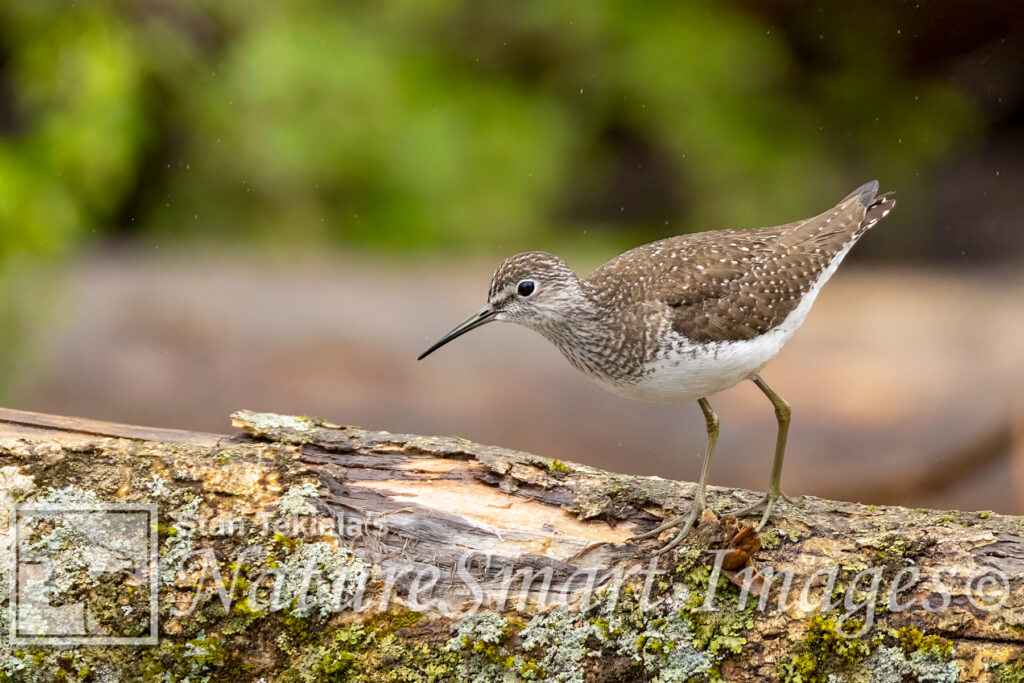
Solitary Sandpiper Breaks Rules
Stan Tekiela loves the diversity found in nature. He also really loves the rule breakers—the critters that don’t seem to follow the rules that we people think they should. Here is the story of what Stan encountered while leading a workshop to photograph black bears in Northern Minnesota. He saw a bird land, and he could clearly see it was a shorebird. Its long legs and long beak, offset by a large, full body, told him it was a solitary sandpiper (Tringa solitaria). Yep, you read that correctly—a sandpiper deep in the Northwoods. How crazy is that? Find out more!
My small group of photographers was following a female black bear with two yearling cubs. The bears were walking through a wetland area with a few fallen trees and a couple of high spots that were dry and covered with green grasses. As we moved closer, I could see a fairly large bird fly out of one of the high spots and land about 5 yards away, right out in the open.
When you think of sandpipers, you automatically think of the ocean or some sandy shore. Or perhaps a freshwater lake or something along those lines. You definitely don’t think of deep northern conifer woods filled with black bears and bobcats.
As its name implies, the solitary sandpiper is usually seen alone, even during migration, although sometimes it can be seen in small congregations of less than 10. It is definitely a freshwater bird that even uses freshwater during winter. It winters in Central and South America, especially in the Amazon River basin where freshwater is abundant. And because of this, there haven’t been many studies done on this species. There is much that isn’t known about this bird.

A Northwoods sandpiper has an interesting habit of bobbing its tail and the back half of its body while it is feeding. The bird likes to hang out in wooded swamps, along small woodland streams, ditches, or flooded fields.
Nesting is where the solitary sandpiper really stands out. There are about 85 different kinds of sandpipers, but it’s the solitary that doesn’t nest on the ground like the others. Instead, the male finds the old nests of other birds such as American robins, rusty blackbirds, and Canada jays. Females will make the final selection and then remove some of the interior lining of the used nest and replace it with fresh plant materials before laying her eggs.
The old nests are usually located near the trunk of a tree, about 6 to 8 feet off the ground. So not only is this sandpiper found in the Northwoods and not at the shore, but it also nests up in trees using old nests and not on the ground like other shorebirds. How much crazier can this bird get?
So now you know why I was so distracted from the black bears when this bird popped up in front of us. Of course, the others in my group really didn’t care about this strange bird in the Northwoods, but only because they didn’t understand how different and cool this shorebird was compared to others.
The solitary sandpiper was first described in the early 1800s by ornithologists, but it wasn’t until the early 1900s that their nesting activity was discovered. It took nearly 100 years before the nesting behavior of this rather unique bird was known.
Over 90% of the global population of the solitary sandpiper breeds in the boreal or Northwoods of North America. Most of this is in Alaska, Canada, and Labrador. In the lower 48 states, it only nests in Northern Minnesota. I think now you can see why I was so happy to get a chance to see and capture some images of this very unusual sandpiper.
If you enjoyed Stan’s post, you might also like: Cranes, Herons & Egrets, Bird Migration: The Incredible Journeys of North American Birds, Wild Birds: North America’s Most Unique Birds, Bald Eagles: The Ultimate Raptors, Owls: The Majestic Hunters, Hummingbirds: Marvels of the Bird World, and, for little tykes, his series of Mamas & Babies board books.
For news on all our books, sign up for our newsletter. #bewellbeoutdoors


